Pressure ulcers, as the name suggests, occur in your body areas as a result of a rather simple yet serious issue: pressure.
These ulcers can be safely compared to your body’s alarm system, which signals you to change positions and relieve that pressure. Prevention and timely intervention are crucial to keep these sores at bay.
But what does it mean when a pressure ulcer is labeled as “unstageable,” and how can such ulcers be effectively treated?
This article will shed light on what pressure ulcers are. What are unstageable pressure ulcers? What are the treatment options available?
What are Pressure Ulcers?
Pressure ulcers have other names, such as bed sores (commonly known), pressure sores, pressure wounds, pressure injuries, or decubitus ulcers.
Individuals, especially older, bedridden, or immobile, with difficulty changing their position regularly, are prone to bedsores. When a skin or underlying tissue, especially a bony region, is subjected to prolonged pressure, bed sores occur.
What Causes Pressure Ulcers?
These ulcers are caused by reduced blood flow to the affected area, which has sustained pressure on the skin or soft tissues. The lack of blood flow causes the skin cells to die. When the dead cells break down, a pressure ulcer injury forms.
Bedsores can develop when there’s pressure, along with
Moisture from sweat, urine, or stool.
Traction, such as pulling or stretching the skin from sliding down in a wheelchair or inclined bed.
These ulcers progress through several stages, ranging from mild skin reddening to open sores that go deep, affecting all three skin layers and tissues and exposing the muscles, tendons, and bones.
Since pressure ulcers can grow large with time and get infected, they must be treated as soon as possible. Because, in some cases, it becomes life-threatening. Studies show that bedsores affect 2.5 million Americans every year.
What Parts of Your Body Do Bedsores Affect?
Bedsores can start anywhere in your body. If you are getting oxygen therapy, it can develop into pressure sores on the bridges of your nose, ears, or behind your head. Sometimes, these ulcers can form inside your mouth when you have improper dentures, intubations, or mechanical ventilation.
But if you ask about the common body areas affected by bedsores, they include any body part with your bones sitting close to your skin.
They include the ankles, elbows, back, heels, hips, buttocks, and tailbone.
What Does Unstageable Pressure Ulcer Mean?
You have heard about pressure ulcers. But what’s an unstageable pressure ulcer? If the health professional struggles with identifying the stage of a bedsore, it’s called an unstageable pressure ulcer.
Symptoms of an unstageable ulcer:
The symptoms of unstageable pressure ulcers include warmth, itching, blistering, and swelling. Sometimes, the skin around the affected area may change color.
Why Does the Ulcer Become Unstageable?
Necrotic tissue, eschar, or a non-removable dressing covers the pressure ulcer or bedsore. Necrotic tissues are dead tissues that must be removed from the wound. Eschar is a thick scab in black or brown formed on the wound. A non-removable dressing is a bandage that has stuck in the affected area.
Also, infection within the wound can lead to the accumulation of pus, debris, and inflammatory tissue. Thus making it difficult to visualize the underlying tissue and assess the ulcer’s stage.
So, these coverings make it challenging to diagnose the wound’s stage accurately.
Thus, giving proper treatment for unstageable pressure ulcers becomes hard. Because they cover the wound, it is difficult to determine the extent of tissue damage or the depth of the wound. Thus, it makes it hard to predict the healing time or estimate the risks or complications.
This is why treating an unstageable pressure ulcer is challenging.
However, it must be treated, right? Unstageable pressure ulcers require careful wound management and the expertise of a wound care specialist.
What is the Severe Type of Pressure Ulcer?
There are four different stages of pressure ulcers. Among them, stage 4 is the last and most severe type. It occurs when there is prolonged pressure on a specific area of the skin. So, the pressure can restrict free flow and oxygen. Thus causing full thickness and tissue loss.
Since the wound goes all the way through the skin, reaching the muscles, bones, joints, and tendons, the injury is deep.
Stage IV ulcers can be quite large and deep, often with well-defined edges that make them look like they’ve been punched out.
These ulcers can vary in severity and come with serious complications, such as infections in the bones or joints, cellulitis, and even sepsis. For instance, not everyone gets infections from their wound.
Sometimes, these complications can be life-threatening, as they could further damage the internal parts. So, proper treatment for unstageable pressure ulcers is important.
Looking for effective pressure ulcer treatment in Thousand Oaks? Contact us today to schedule a consultation and get specialized treatment and care.
What Are the Signs of an Infected Bedsore?
Some of the first signs of an infection in pressure ulcers are
Extreme pain
Foul smell
Red-colored and warm to the touch
Swollen
Oozing pus
Diagnosis and tests
How do you know if you are having pressure ulcers in the first place? Your wound specialist will provide a proper diagnosis of bedsores and their stage based on their appearance. You may be asked to get certain tests to check for infections, like biopsies, blood cultures and tests, and X-rays or MRIs.
What Is the Best Treatment for Pressure Ulcers?
Only when you remove the necrotic coverings on the wound can you identify the stage of the pressure ulcers. So, the first goal of the treatment is to remove the unwanted coverings via debridement. It’s a process where the dead or infected tissues in and around the wound are removed.
When they are removed, the health care professional gets the proper staging and wound assessment needed to determine the appropriate course of treatment.
If it is a stage 1 or 2 pressure ulcer, you can easily treat it using medication and cure it. But if it’s stage 3 or 4, your wound specialist would take extra care and give treatment based on the severity of the ulcer.
Non-surgical treatment
Specialists from the wound care center in Thousand Oaks would recommend treating the pressure ulcers using non-surgical ways.
Special medical bandages
To treat the pressure ulcer injury, you or your healthcare provider may perform the following:
Cleaning the wound with soap and water or saline.
Covering the wound with special medical bandages designed to promote healing.
These bandages include water-based gel (hydrogel), alginates (seaweed), hydrocolloid, and foam dressings.
Negative Pressure Wound Therapy
This is called vacuum-assisted wound closure therapy. It’s a wound management system that applies sub-atmospheric pressure to reduce inflammatory exudate and promote the growth of granulation tissue.
How’s it done?
A piece of foam dressing matching the size of the wound is cut and placed over the wound.
Next, a drain tube is placed on top of the foam.
Then, cover the foam dressing, the first few inches of the drain tube, and the skin around the wound area using transparent tape.
Now, the far end of the drain is connected to a machine that can create negative pressure, and its desired pressure level is set.
When the machine is turned on, it removes the air from the foam dressing, causing it to collapse inwards, pulling the wound’s edges closer together.
By doing so, the fluid present in the wound is absorbed by the foam and carried into a disposable canister within the main machine that generates negative pressure.
This therapy helps in healing not just pressure ulcers but also venous ulcers, diabetic ulcers, arterial ulcers, first- and second-degree burns, etc.
Wound care specialists from the top pressure ulcer treatment in Oxnard say that they treat the ulcer based on its severity. The negative pressure wound therapy treatment has become popular for the management of acute and chronic wounds.
How Can You Prevent Pressure Ulcers or Bedsores?
If you want to reduce the risk of bedsores or pressure ulcers, take the following precautions:
Change positions every 15 minutes if you are seated. If you are in bed, do it every one or two hours. If you can’t reposition independently, instruct your caregiver to do it.
Regularly checking your skin is highly recommended. Look for changes in skin color and sensations such as tenderness or pain, warmth, or coolness.
Clean your skin and keep it dry. Try applying moisture barrier creams to protect your skin from sweat, urine, and stools.
Maintain current levels of mobility, activity and range of motion. It’s best to do physical therapy exercises.
Follow a healthy, nutritious diet and stay well hydrated.
Change and wash your clothes, especially your undergarments. Also, change your bedsheets.
Lower the head of the bed to minimize the risk of shearing.
Utilize positioning devices to avoid prolonged pressure on areas with bony protrusions.
Avoid massaging bony prominences.
If you want pressure ulcer treatment or want to learn more about prevention care, visit the top wound care centers in Ventura. These centers often have experienced healthcare professionals and specialized equipment for effective wound care.
Final Words
If you are bedridden or have limited mobility, call your healthcare professional if you notice changes in skin color, signs of infection, skin tenderness, pain, or warmth. These are the primary signs of bedsores.
Also, in most cases, people who develop bedsores are malnourished. Remember that malnutrition can attack elderly people and those suffering from health conditions.
To prevent bedsores or to heal them faster, proper nutrition is a must.
Here, having a caregiver or a loved one look after you or any individual suffering from bedsores is important. Also, proper medical care is critical.
If you find yourself developing the symptoms, get in touch with our wound care center in Los Angeles. Our team of specialists will provide expert evaluation, personalized treatment, and compassionate care to help you on your path to healing and recovery








